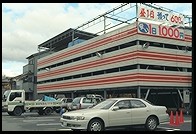
How to Photograph Architecture (Exterior) :
This is an example-based tutorial on photographing buildings.
Your Pictures Need Not Be Pretty
Architectural photography at its best will convey the experience of being in and around a built environment. In the case of the Dachau Concentration Camp, this won't result in comforting attractive images.
Below is a parking garage in Kyoto. The colors and industrial appearance of the structure are remarkable in the middle of a city known for its ancient temples and gardens. The purpose of the image is to capture the feeling of walking by the structure, not to delight or decorate.

A supermarket exterior is a subject that will probably never make a wall-worthy image by itself. However, the image below (from the Hawaii flowers collection) captures the spirit of being in the parking lot at night

Give Old Buildings Some Space
In general, the older the structure, the more environmental context is required.





Watch the Shadows
Before color, Hollywood directors and cinematographers worked carefully to cast interesting shadows into scenes. Here are some examples of images where shadows set the mood.



Lead the Eye by Leading the Person
Natural Frames
It is a contrived and hackneyed idea, but it does work to use natural frames. If you're working without a tripod, you probably won't be able to stop down the aperture enough to get everything into focus. But it is okay to have a soft frame and a sharp subject.
People
Include people in an architecture photo if they give unexpected information about how a building is being used.

Don't Forget the Sculptures
Fountains
Bridges
The three pictures below show increasingly less literal views of the Golden Gate Bridge in San Francisco. My favorite is the one on the right. It isn't a very good view of the bridge--one can hardly see that there are two towers--but it shows tourists gawking at the bridge's construction and an avid cyclist using the bridge.
For the next bridge, the story behind it is more important than the structure. This is the Dike Bridge on Chappaquiddick, a subisland of Martha's Vineyard, Massachusetts (almost part of Cape Cod). In 1969, Ted Kennedy drove off the side of this bridge into the water. He abandoned his passenger, Mary Jo Kopechne, to her death by drowning. Kennedy did not report the incident to the police until the following morning and was found guilty of leaving the scene of an accident. The bridge fell into disrepair and was subsequently rebuilt to absurdly heavy duty standards. The photographs below therefore concentrate on the super-strong guard rails and the heavy metal gate that is used to close the bridge every night.
Doors and Windows



Details
A good architect is a fanatic for detail and some of the most beautiful parts of a structure are best captured in isolation.
Night
A lot of buildings become more interesting at night:



With digital cameras, the main problem is noise from the sensor, which is best controlled by using a tripod and keeping the ISO set to 400 or less. In general, physically larger sensors will produce less noise than smaller sensors, which is why digital SLRs perform so much better in low light than point and shoot digicams.
Modern 35mm single-lens reflex cameras have such good metering systems that the suggested exposure for a picture like the ones above is almost always within 1 f-stop of the best exposure. With slide film, it is probably best to take 5 bracketed exposures at 1/2 f-stop intervals. With color negative film, take four pictures: one at 1 f-stop less exposure than recommended, one at the camera's recommended exposure, one 1 f-stop over, and one 2 f-stops over.





















